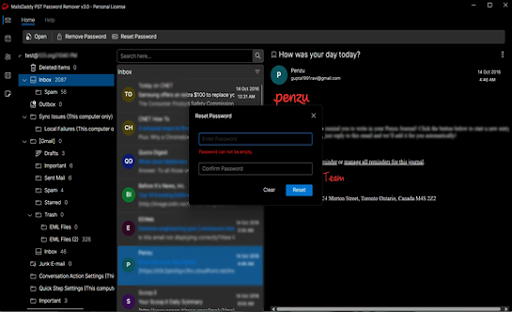Forget your Outlook PST password! Know the manual and third-party solution to unlock a password-protected PST file in a few simple clicks.
Misplacing or forgetting the password
of your Outlook PST files can be inconvenient, especially when you cannot
access to email, calendar, and contacts. PST files are essential for storing
all your Outlook mailbox data securely. If you cannot recall the password of
PST files, there is no need to worry. with a reliable tool like MailsDaddy PST
password remover, you can quickly and securely unlock your file
What are PST files?
A PST file (Personal Storage Table) is
a special file used by Microsoft Outlook to save your emails, contacts,
calendar, and other information on your computer. With the help of PST files,
you can easily export or back up your mailbox, and also open them on another
computer.
A question arises - Why do we lock PST Files?
Any size organization can use
Microsoft Outlook and create a PST file to save all its valuable data. Now,
when we have any valuable information, it is usually safe, secure, and
important to keep it password protected. But what if we lose or forget it?
This is a very common situation as you
can no longer access your mailbox. In this case, we only have manual and
third-party approaches to unlock it.
Methods of Changing Passwords in Outlook
There are two prime methods to reuse
your PST file as before:
1.
Manual Method (Free
Method)
2.
Third-party solution
Manual method
First of all, let’s talk about the
manual method because it's a free and easy way to change your Outlook PST
password. In this section, we'll explain how to change the password using
Outlook features:
- MS Outlook
Change PST Password In MS Outlook-
If you’re using Outlook installed on
your computer (like Outlook 2019, 2016, and Earlier versions) then follow these steps-
- Open Microsoft Outlook.
- Click on the File menu at the
top.
- Go to Account Settings, then
click on them
- In the new window, go to the Data
Files
- Select the PST file you want to
update, then click on Settings.
- Now click the Change Password
button.
- A pop-up will appear:
- Enter the old password (leave it
empty)
- Enter your new password, then
confirm.
- Click OK, then restart Outlook.
After reading the manual method, you
must have understood that it works only if you have the old password.
Otherwise, you can adopt the manual method. In case you lose or forget the
password, try a third-party application.
Third-party solution –
There are many third-party solutions
available on the internet, and you are free to use anyone of them. But here we
are going to share the MailsDaddy PST Password Remover Tool. This
easy-to-use software helps you quickly remove and change passwords from Outlook
PST files. It works with all versions of MS Outlook and has a simple interface,
so both technical and non-technical users can use it without any problem.
Try free: https://www.mailsdaddy.com/pst-password-remover/
To change the password, follow these
simple steps-
1.
Open the application on
your system.
2.
Select the
password-protected PST file.
3.
Now the user can use two
options to unlock it:
a.
Remove Password: With
the remove button, the user does not need to set any password, and a
password-free PST file is generated.
b.
Reset Password: With the
reset button, the user can add a new password in the PST file without using the
old one.
4.
The file will
automatically save the same browsing location, including the name of the reset
or remove.
5.
Hit OK to finish the
process and go to the location to open in Outlook.
Conclusion
In this article, we have explained two
easy ways to change your Outlook password. We hope this guide helps you update
your password without any trouble. You can choose any method that best suits
your technical knowledge. If you face any issues or have questions, feel free
to reach out — we will do our best to help you quickly.






0 Comments